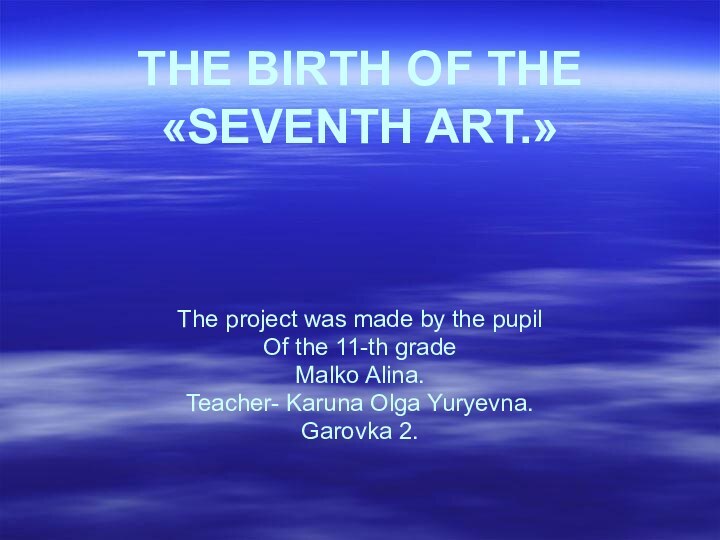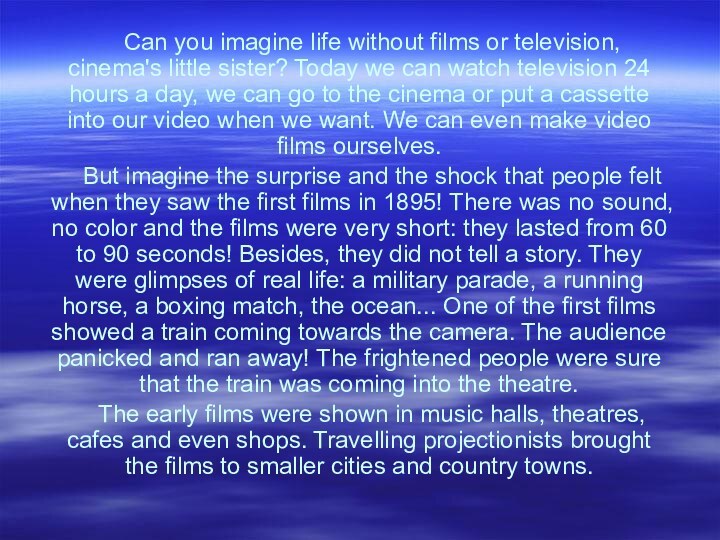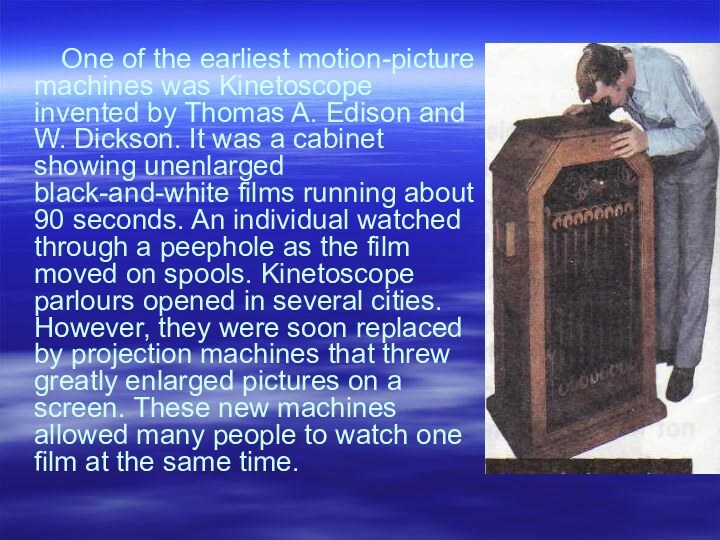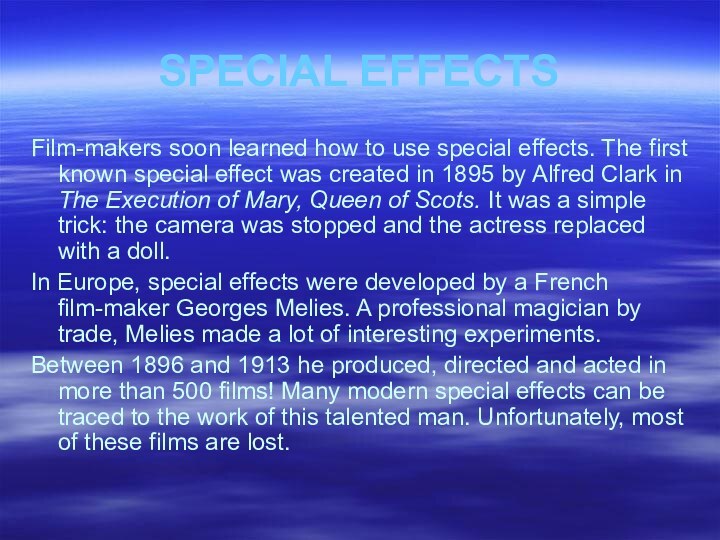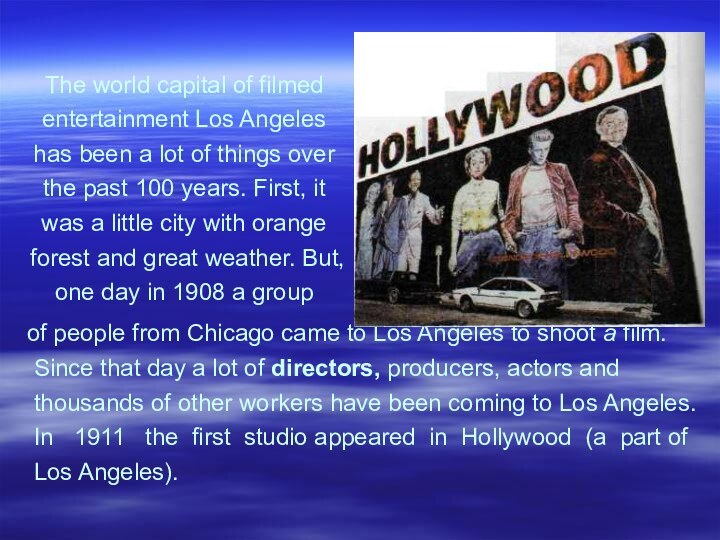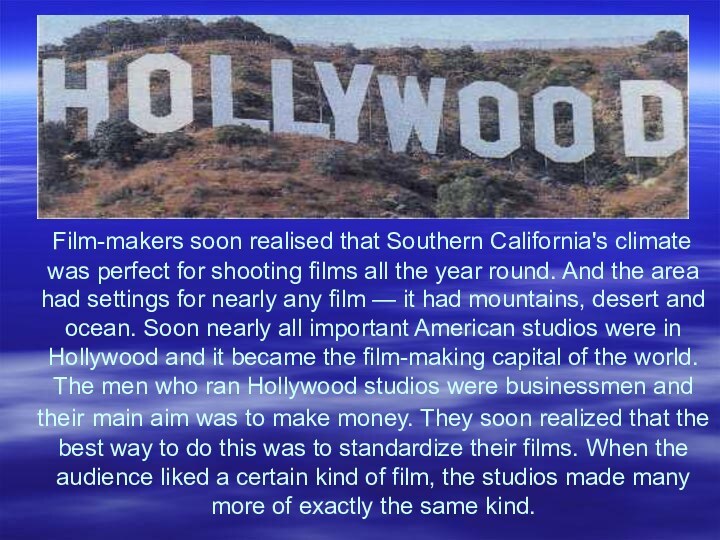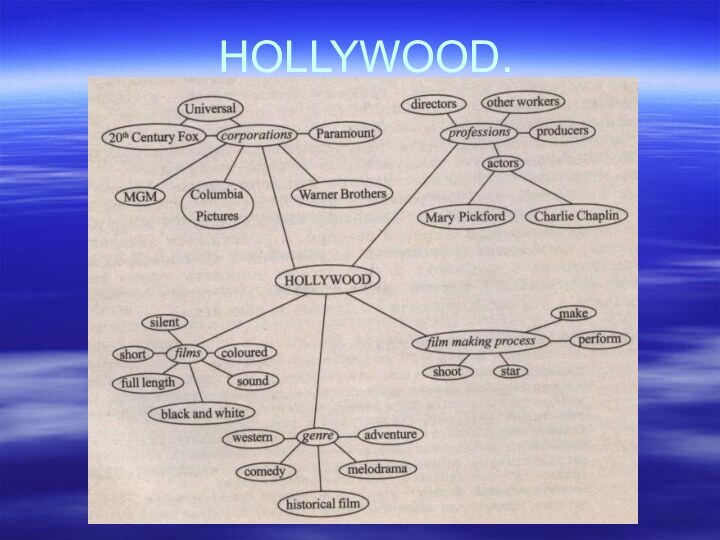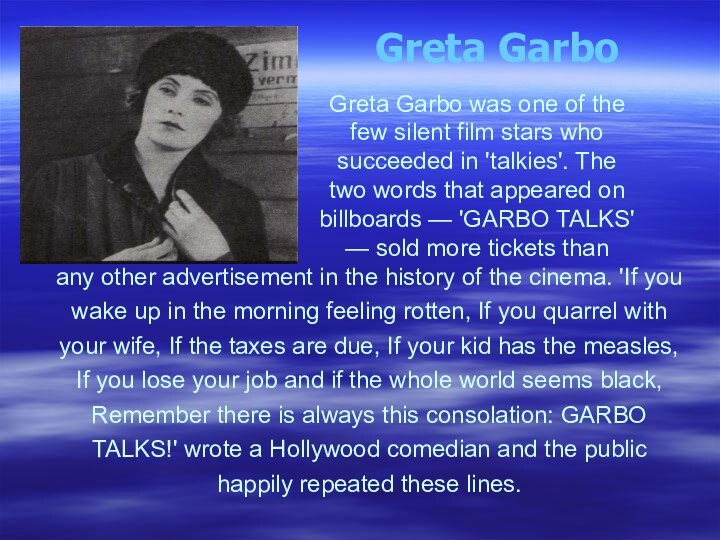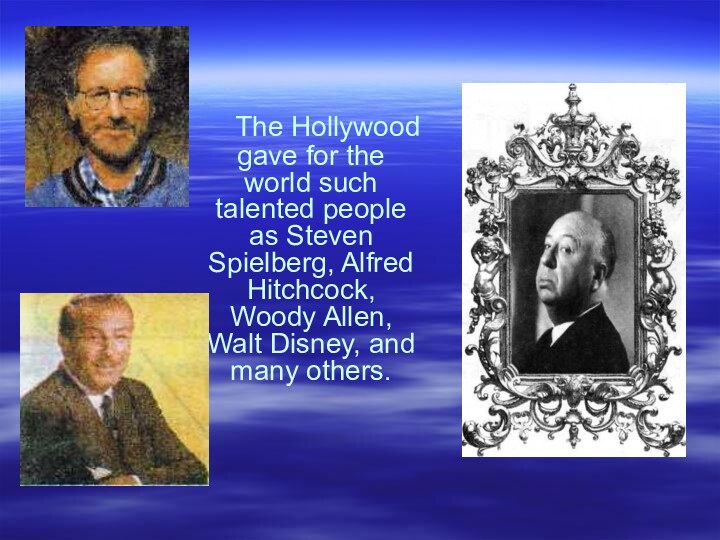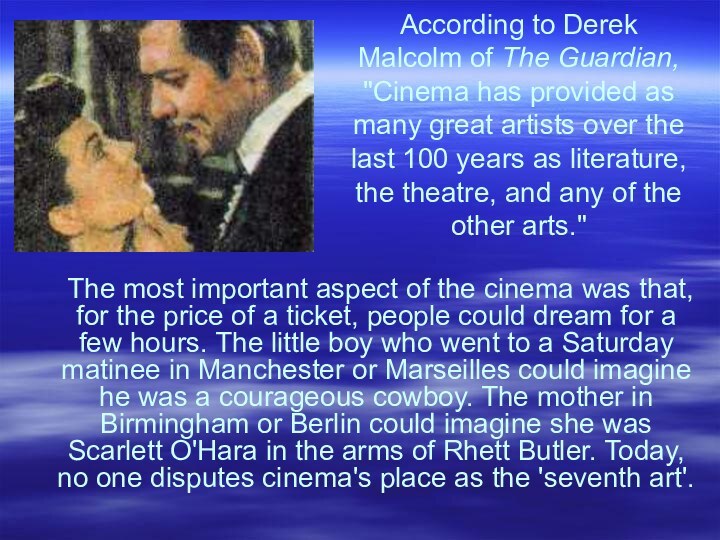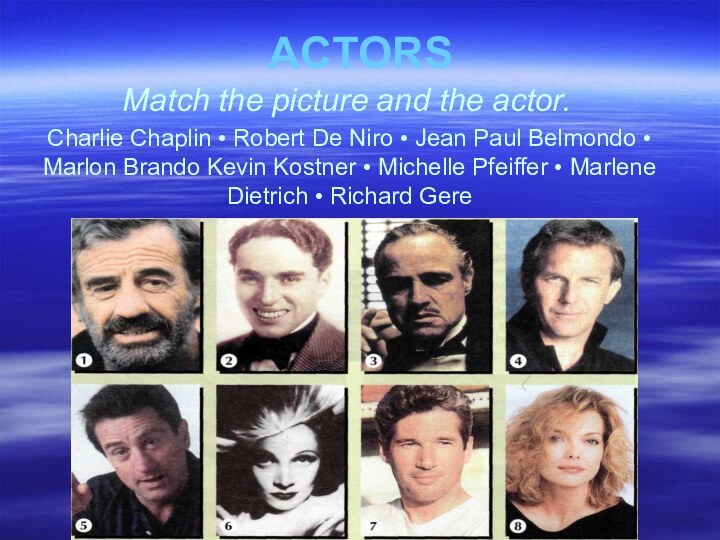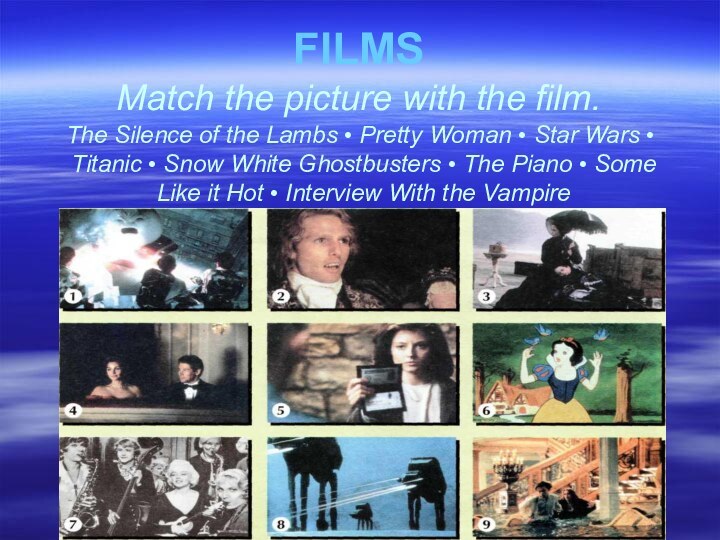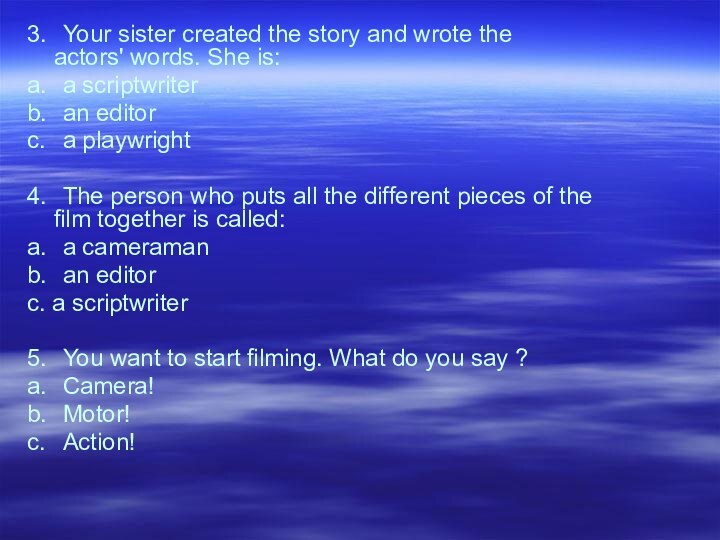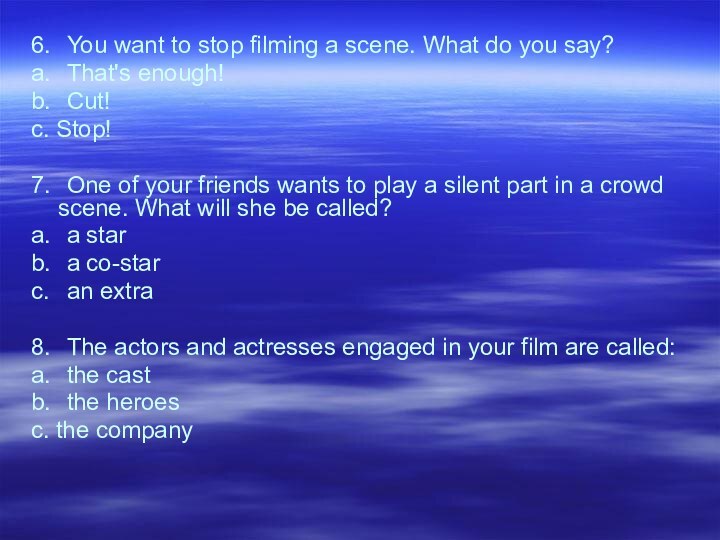Слайд 2
The twentieth century may be called
the century
of film making.
Cinema and TV films have become
an
important part of our lives.
But not everyone knows when and
how cinematography appeared.
Слайд 3
Can you imagine life
without films or television, cinema's little sister? Today we
can watch television 24 hours a day, we can go to the cinema or put a cassette into our video when we want. We can even make video films ourselves.
But imagine the surprise and the shock that people felt when they saw the first films in 1895! There was no sound, no color and the films were very short: they lasted from 60 to 90 seconds! Besides, they did not tell a story. They were glimpses of real life: a military parade, a running horse, a boxing match, the ocean... One of the first films showed a train coming towards the camera. The audience panicked and ran away! The frightened people were sure that the train was coming into the theatre.
The early films were shown in music halls, theatres, cafes and even shops. Travelling projectiоnists brought the films to smaller cities and country towns.
Слайд 4
Many people contributed to the invention of the
cinema — the brothers Louis Jean and Auguste Lumiere
in France; Thomas Alva Edison in the United States; William Friese-Creene and Robert W. Paul in Great Britain. As a result, several different types of motion-picture cameras and projectors appeared in the mid-1890s.The French Lumiere brothers were the first to show a film in public. It happened on December 28, 1895 in the basement of a Paris cafe. During 1896 the Lumieres made more than 40 films! They showed everyday French life: the arrival of a train, a game of cards, the activity of a street life... The Lumieres also made the first newsreel, a film of the French Photographic Society Conference, and the first comedy shot.
Слайд 5
One of the earliest
motion-picture machines was Kinetoscope invented by Thomas A. Edison
and W. Dickson. It was a cabinet showing unenlarged black-and-white films running about 90 seconds. An individual watched through a peephole as the film moved on spools. Kinetoscope parlours opened in several cities. However, they were soon replaced by projection machines that threw greatly enlarged pictures on a screen. These new machines allowed many people to watch one film at the same time.
Слайд 6
Pioneers of the Russian
cinema are Protazanov, Gardin, Bauer, and later Eisenstein, Pudovkin,
Dovzhenko. The first films in the West were mainly melodramas or comedies. In Russia, they were very often historical films or screen versions of the best novels.
Слайд 7
IS IT ART?
The cinema was the
perfect popular entertainment. It was not expensive and,
at first, the audience consisted mainly of workers. The rich and intellectual classes ignored it. They didn't think it was art. For example, the London Times wrote about one of the Lumiere brothers' first shows in 1896 and didn't mention the cinema again until 1904!
Слайд 8
FILMS BEGIN TO TELL STORIES
Gradually films became longer
and started to tell stories. Edwin S. Porter was
one of the first directors who made such a film in 1903. It was The Great Train Robbery, the first Western in the history of the cinema. It told a primitive but dramatic story about bandits holding up a train. Gilbert M. Anderson (Bronco Billy) played in this film, as he said, 'everything but the camera'. He rode a horse. He was a passenger on the train who was killed and he was also the bandit who shot him. This 11-minute film became a sensational hit. Porter's film and the storytelling films that followed made the cinema still more popular. In the United States, 'nickelodeons' began to appear.
Слайд 9
Nickelodeons' were cinemas where people paid a nickel
(5 cents) to see several short films. It was
much cheaper than other entertainments and everybody could afford it.
As soon as the films learned to tell stories, they began to film the classics.
Silent films had orchestras, organists or pianists. Later, printed titles were invented. The titles gave dialogue, descriptions of action, or commentary.
Слайд 10
The Western was the only type of early
film which was unique to the cinema. People knew
comedies, romances, police stories and melodramas from the theatre. But the Western was new, and especially popular with children.
Слайд 11
SPECIAL EFFECTS
Film-makers soon learned how to use special
effects. The first known special effect was created in
1895 by Alfred Clark in The Execution of Mary, Queen of Scots. It was a simple trick: the camera was stopped and the actress replaced with a doll.
In Europe, special effects were developed by a French film-maker Georges Melies. A professional magician by trade, Melies made a lot of interesting experiments.
Between 1896 and 1913 he produced, directed and acted in more than 500 films! Many modern special effects can be traced to the work of this talented man. Unfortunately, most of these films are lost.
Слайд 12
With special effects films become more exciting,
and sometimes more frightening.
Слайд 13
When directors make their films, they
can use many special effects. For example, in the
film Who Framed Roger Rabbit cartoon characters play with live actors.
Слайд 15
The world capital of filmed entertainment Los Angeles
has been a lot of things over the past
100 years. First, it was a little city with orange forest and great weather. But, one day in 1908 a group
of people from Chicago came to Los Angeles to shoot a film. Since that day a lot of directors, producers, actors and thousands of other workers have been coming to Los Angeles. In 1911 the first studio appeared in Hollywood (a part of Los Angeles).
Слайд 16
Film-makers soon realised that Southern California's
climate was perfect for shooting films all the year
round. And the area had settings for nearly any film — it had mountains, desert and ocean. Soon nearly all important American studios were in Hollywood and it became the film-making capital of the world. The men who ran Hollywood studios were businessmen and their main aim was to make money. They soon realized that the best way to do this was to standardize their films. When the audience liked a certain kind of film, the studios made many more of exactly the same kind.
Слайд 17
By the 1920s, 80 percent of world films
were produced in Hollywood.
Making films is expensive.
On the average, it costs 36 million dollars to produce a film. Some of this goes to pay the actors, and large sums can be spent on special effects. Marketing the film to the public may cost another 17 million dollars...
Слайд 19
people in different countries could see
the same actors and actresses at the cinema. Their
faces, and later their voices, were familiar to people in the countries they never visited.
As the industry developed, it created a new phenomenon: the international star. World travel was still slow and difficult in those days, but millions of
MOVIE
STARS
Слайд 20
It was an entirely new experience to see
a 'star', someone to identify with and love from
a distance. All over the world, from Paris to Tokyo, from London to New York, millions of people stood in long queues to see their favourite stars.
A famous star could make any film a certain success. So the studios went to great lengths to make their actors into stars. The publicity department gave them an image, and often a name. They dictated the clothes the stars wore, where they lived, what parties they went to...
The Soviet flag in Sergey Eisenstein's «Battleship Potemkin» was tinted red.
The introduction of colour was less revolutionary than the introduction of sound. The silent film soon disappeared, but the black-and-white films are made even today.
Слайд 21
By 1916, Charlie Chaplin had what
was probably the best-known face in the world, the
public transformed him from a star into a mythic figure. Cartoons, poems and comic strips under the Chaplin name appeared in newspapers. Chaplin dolls, toys and boots were manufactured. This little man made the whole world laugh with his films. Like many silent film stars, he didn't succeed in 'talkies'.
CHARLIE CHAPLIN-STAR
OF THE SILENT FILM
Слайд 22
MARY PICKFORD-«AMERICA’S SWEETHEART»
Mary Pickford was one
of the early stars of silent cinema. She was
also the first female millionaire.
"I can't afford to work for only 10,000 dollars a week," she used to say. Thousands of young girls went to Hollywood hoping to become rich and famous like her.
Слайд 23
The 1930s was the golden era of the
Hollywood studio film. It was the decade of the
great movie stars — Greta Garbo, Marlene Dietrich, Jean Harlow, Mae West, Katharine Hepburn, Bette Davis, Cary Grant, Gary Cooper, Clark Gable — and of a new generation of great directors. It was also the time when two new kinds of films — the musical and the gangster film — first appeared on the screen.
Слайд 24
Greta Garbo was one of the few silent
film stars who
succeeded in 'talkies'. The two words that
appeared on
billboards — 'GARBO TALKS' — sold more tickets than
any other advertisement in the history of the cinema. 'If you wake up in the morning feeling rotten, If you quarrel with your wife, If the taxes are due, If your kid has the measles, If you lose your job and if the whole world seems black, Remember there is always this consolation: GARBO TALKS!' wrote a Hollywood comedian and the public happily repeated these lines.
Greta Garbo
Слайд 25
Marilyn Monroe was a perfect example of a
Hollywood studio star. Her great beauty made her a
world-famous sex symbol. But in spite of her success in films, Monroe had a tragic life. She died at the age of 36 from an overdose of sleeping pills. Since her death she has become one of the most written-about film stars in history.
Слайд 26
The Hollywood gave for the
world such talented people as Steven Spielberg, Alfred Hitchcock,
Woody Allen, Walt Disney, and many others.
Слайд 27
Today, Hollywood is not what it was. Many
studios have moved to other places. The film stars
have also moved to areas like Beverly Hills and Malibu. But visitors to Hollywood today can go to the famous Chinese Theatre and see the footprints and autographs of famous film stars. They can go down the Walk of Fame and see the golden stars on the pavement...
Слайд 28
ART OR RELIGION?
The popularity of the
cinema led to the first attacks against it. Church
leaders condemned the new form. They thought that the cinema would steal souls and lead people away from religion. Indeed, early cinemas looked like temples, and people worshipped their favourite film stars.
Слайд 29
TALKIES
The era of the talking film
began in 1927 with the enormous success of Warner
Brothers' The Jazz Singer. The film mostly told its story with titles, but it had three songs and a short dialogue. There were long queues in front of the Warner Theatre in New York... The silent film was dead within a year.
The first 100% sound film, Lights of New York, appeared in 1928.
The first colour films were made in the 1930s. Before that films were usually tinted.
Слайд 30
According to Derek Malcolm of The Guardian, "Cinema
has provided as many great artists over the last
100 years as literature, the theatre, and any of the other arts."
The most important aspect of the cinema was that, for the price of a ticket, people could dream for a few hours. The little boy who went to a Saturday matinee in Manchester or Marseilles could imagine he was a courageous cowboy. The mother in Birmingham or Berlin could imagine she was Scarlett O'Hara in the arms of Rhett Butler. Today, no one disputes cinema's place as the 'seventh art'.
the picture and the actor.
Charlie Chaplin •
Robert De Niro • Jean Paul Belmondo • Marlon Brando Kevin Kostner • Michelle Pfeiffer • Marlene Dietrich • Richard Gere
Слайд 32
FILM DIRECTORS
Match the first names with the surnames
of famous directors.
Woody
а. Spielberg
Orson b. Bergman
Alfred с. Allen
Ingmar d. Bertollucci
Bernardo e. Tarkovsky
Steven f. Welles
Federico g. Polanski
Roman h. Hitchcock
Andrei i. Fellini
1. A
film with lots of music and dance.
b. science fiction 2. A film in which unnatural and frightening things happen, such as dead
people coming to life, people turning into
animals, etc.
c. Thriller 3. An action-packed film about cowboys, horses and gunfights.
d. Comedy 4. A film about space travel or life in an imaginary future.
e. horror 5. A film made by photographing a set of drawings.
f. cartoon 6. A suspense film full of violence and crime.
g. musical 7. An amusing film with a happy ending.
Film genres
Match the genre with the discription
Слайд 34
FILMS
Match the picture with the film.
The
Silence of the Lambs • Pretty Woman • Star
Wars • Titanic • Snow White Ghostbusters • The Piano • Some Like it Hot • Interview With the Vampire
Слайд 35
MOVIE TALK
1. You tell the actors what
to do:
you are the
a. director
b. producer
c. cameraman
2. Your uncle is financing
the film. What is
he
called?
a. the director
b. the producer
c. the bank manager
Слайд 36
3. Your sister created the story and wrote the
actors'
words. She is:
a. a scriptwriter
b. an editor
c. a playwright
4. The person who puts
all the different pieces of the
film together is called:
a. a cameraman
b. an editor
с. a scriptwriter
5. You want to start filming. What do you say ?
a. Camera!
b. Motor!
c. Action!
